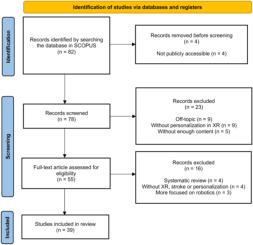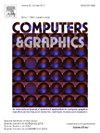Personalized eXtended Reality experiences to enhance the rehabilitation process of stroke survivors: A scoping review
IF 2.8
4区 计算机科学
Q2 COMPUTER SCIENCE, SOFTWARE ENGINEERING
引用次数: 0
Abstract
Stroke affects millions globally, resulting in physical impairments such as paralysis, speech challenges, and cognitive deficits like memory loss. Rehabilitation plays a vital role in recovery, helping regain lost functions, and achieve greater independence, facilitating reintegration into daily life. Despite this, rehabilitation programs rely on standardized approaches that fail to accommodate the unique needs and goals of individual stroke survivors. This lack of personalization can lead to frustration, loss of motivation, and reduced engagement, ultimately hindering recovery and slowing progress. One possible approach to help overcome these challenges is eXtended Reality (XR), offering immersive, adaptable virtual environments. XR enables the creation of dynamic and customizable exercises tailored to the specific needs, abilities, and preferences of each individual. These experiences can be interactive and engaging, improving motivation and fostering active participation compared to traditional methods. XR also allows for real-time tracking and feedback, making the process both more effective and enjoyable. This work contributes to the field by presenting a scoping review on personalized XR experiences for stroke rehabilitation, resulting from an analysis of 39 publications within the SCOPUS database covering the period from 2020 to 2024. The review provides insights into trends, advancements, and challenges, identifying opportunities for future development in this area. By consolidating knowledge in this field, we aim to help guide the development of personalized XR solutions, ultimately improving rehabilitation outcomes and quality of life for stroke survivors and their caregivers.

个性化的扩展现实体验,以加强中风幸存者的康复过程:范围审查
中风影响全球数百万人,导致瘫痪等身体损伤、语言障碍和记忆丧失等认知缺陷。康复在康复中起着至关重要的作用,有助于恢复失去的功能,获得更大的独立性,促进重新融入日常生活。尽管如此,康复计划依赖于标准化的方法,无法适应个体中风幸存者的独特需求和目标。这种缺乏个性化会导致沮丧,失去动力,降低参与度,最终阻碍康复并减缓进步。帮助克服这些挑战的一种可能的方法是扩展现实(XR),提供沉浸式的、可适应的虚拟环境。XR允许根据每个人的特定需求、能力和偏好创建动态和可定制的练习。与传统方法相比,这些体验具有互动性和吸引力,可以提高积极性,促进积极参与。XR还允许实时跟踪和反馈,使过程更有效和愉快。这项工作通过对SCOPUS数据库中涵盖2020年至2024年期间的39篇出版物进行分析,对中风康复的个性化XR体验进行了范围审查,从而为该领域做出了贡献。该报告提供了对趋势、进步和挑战的见解,并确定了该领域未来发展的机会。通过巩固这一领域的知识,我们的目标是帮助指导个性化XR解决方案的发展,最终改善中风幸存者及其护理人员的康复效果和生活质量。
本文章由计算机程序翻译,如有差异,请以英文原文为准。
求助全文
约1分钟内获得全文
求助全文
来源期刊

Computers & Graphics-Uk
工程技术-计算机:软件工程
CiteScore
5.30
自引率
12.00%
发文量
173
审稿时长
38 days
期刊介绍:
Computers & Graphics is dedicated to disseminate information on research and applications of computer graphics (CG) techniques. The journal encourages articles on:
1. Research and applications of interactive computer graphics. We are particularly interested in novel interaction techniques and applications of CG to problem domains.
2. State-of-the-art papers on late-breaking, cutting-edge research on CG.
3. Information on innovative uses of graphics principles and technologies.
4. Tutorial papers on both teaching CG principles and innovative uses of CG in education.
 求助内容:
求助内容: 应助结果提醒方式:
应助结果提醒方式:


